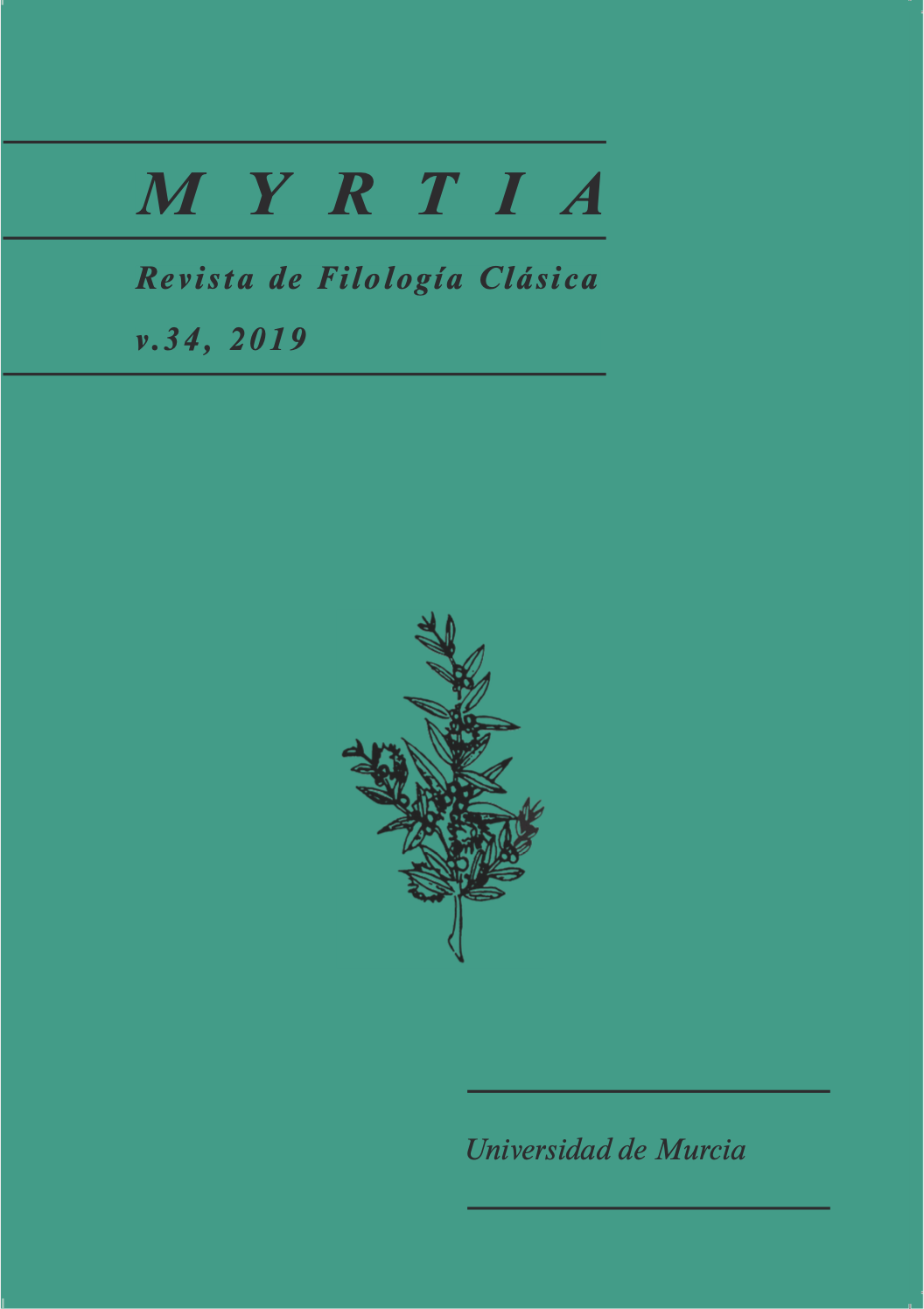The Homeric Cimmerians (Od. XI 11-19) and their presence in Greek and Latin literature
Abstract
In canto Odyssey XI a description of the Cimmerian people is included for the first time as part of a journey to the netherworld’s narrative. In this paper a comparative analysis of the Homeric passage and of various texts from Greek and Latin literature is carried out in order to show how, since Homer, the Cimmerians became a traditional motive of this theme. For that purpose, the similarities and differences produced in terms of the presence, name, characteristics and location of this mythical town have been explained in each text regarding the Homeric model.
Downloads
-
Abstract1495
-
PDF (Español (España))1127
References
BAERTSCHI, A. M. (201): Nekyiai. Totenbeschwörung und Unterweltsbegegnung im neronischflavischen Epos, Berlin.
BRIDGMAN, T. (1998): “Who were the Cimmerians?”, Hermathena 164, pp. 31-64.
BRIOSO SÁNCHEZ, M. (2002): “El motivo del viaje en Las historias increíbles de más allá de Tule de Antonio Diógenes”, Fortunatae 13, pp. 65-87.
BURGESS, J.S. (2016): “Localization of the Odyssey's Underworld”, CÉA 53, pp. 15-37.
BURY, J. B. (1906): “The Homeric and the Historic Kimmerians”, Klio 6, pp. 77-88.
CLARK, R. J. (1979): Catabasis: Vergil and the Wisdom-Tradition, Amsterdam.
COUSIN, C. (2005): “La Nékyia homérique et les fragments des Évocateurs d'âmes d'Eschyle”, Gaia 9, pp. 137-152.
FRENZEL, E. (1980): Diccionario de motivos de la Literatura Universal, trad. M. Albella Martín, Madrid.
GARCÍA LÓPEZ, J. (1993): Aristófanes. Las Ranas. Introducción, comentario y traducción, Murcia.
GEORGE, A. R. (ed.) (2003): The Babylonian Gilgamesh Epic. Introduction, Critical Edition and Cuneiform Texts, 2 vols., Oxford.
HEUBECK, A. (1988): “Books IX-XII”, en A. Heubeck - A. Hoekstra, A Commentary on Homer's “Odyssey”. Volume II. Books IX-XVI, Oxford, pp. 1-143.
HÖLSCHER, U. (1991): L'Odissea. Epos tra fiaba e romanzo, trad. F. Stella, Firenze.
IVANTCHIK, A. I. (1993): Les Cimmériens au Proche-Orient (OBO 127), Fribourg - Göttingen.
IVANTCHIK, A. I. (2005): “Le dêmos et la polis des Cimmériens dans l’Odyssée (XI, 14): le contenu de l’image épique”, en D. Kacharava - M. Faudot - E. Geny (eds.), Pont-Euxin et polis, (Actes du Xe Symposium de Vani), Besançon, pp. 83-98.
JUHNKE, H. (1972): Homerisches in römischer Epik flavischer Zeit, München.
KLAASSEN, E. K. (201): “Imitation and the Hero”, en A. Augoustakis (ed.), Brill's Companion to Silius Italicus, Leiden, pp. 99-126.
LARA PEINADO, F. (2002): Leyendas de la Antigua Mesopotamia: Dioses, héroes y seres fantásticos, Madrid.
LINARES SÁNCHEZ, J. J. (2017): El tema del viaje al mundo de los muertos en la Odisea y su tradición en la literatura occidental (Tesis Doctoral), Murcia.
LUCAS DE DIOS, J. M. (2008): Esquilo: Fragmentos. Testimonios, Madrid.
MACÍAS OTERO, S. M. (2015): “On the Threshold of Hades: Necromancy and Nékyia in some Passages of Greek Tragedy”, LÉC 83, pp. 137-153.
MATIJEVIĆ, K. (2015): Ursprung und Charakter der homerischen Jenseitsvorstellungen, Paderborn.
MIKELLIDOU, K. (2016): “Aeschylus reading Homer: the Case of the Psychagogoi”, en A. Efstathiou - I. Karamanou (eds.), Homeric Receptions across Generic and Cultural Contexts, Berlin - Boston, pp. 331-341.
MOST, G. W. (2016): “Allegoresis and Etymology”, en A. Grafton - G. W. Most (eds.), Canonical Texts and Scholarly Practices: A Global Comparative Approach, Cambridge, pp. 52-74.
NORMAN, B. (2016): “Re-assessing the Location of the Homeric Underworld in the Odyssey Book XI”, International Journal of Student Research in Archaeology 1.1, pp. 1-14.
OGDEN, D. (2001): Greek and Roman Necromancy, Princeton.
OGDEN, D. (2014): “How ‘Western’ were the Ancient Oracles of the Dead?”, en L. Breglia - A. Moleti (eds.), Hespería: Tradizioni, Rotte, Paesaggi, Paestum, pp. 211-226.
OLLER GUZMÁN, M. (2014): “Fantasmas de Aquiles: epifanías heroicas entre el mito y el culto”, Minerva 27, pp. 77-96.
PONCHIA, S. (2002): “Odisseo e Gilgamesh: viaggi a confronto”, en L. de Finis – V. Citti – L. Belloni (eds.), Odisseo dal Mediterraneo all'Europa, Amsterdam, pp. 9-21.
PROPP, V. (1979): Las raíces históricas del cuento, trad. J. Martín Arancibia, Madrid.
SANTAMARÍA ÁLVAREZ, M. A. (2015): “The Parody of the Katábasis-Motif in Aristophanes' Frogs”, LÉC 83, p. 117-136.
THOMPSON, S. (1955): Motif-Index of Folk-Literature, vol. III: F-H, Indianapolis.
TSAGARAKIS, O. (2000): Studies in Odyssey 11, Stuttgart.
VAN DER KEUR, M. (2014): “Meruit deus esse videtur: Silius' Homer in Homer's Punica 13”, en A. Augoustakis (ed.), Flavian Poetry and its Greek Past, Leiden, pp. 287-304.
WEBSTER, T. B. L. (1958): From Mycenae to Homer, London.
WEST, M. L. (2003) [1997]: The East Face of Helicon: West Asiatic Elements in Greek Poetry and Myth, Oxford.
WEST, M. L. (2005): “Odyssey and Argonautica”, CQ 55.1, pp. 39-64.
WEST, M. L. (2014): The Making of the Odyssey, Oxford.
Las obras que se publican en esta revista están sujetas a los siguientes términos:
1. El Servicio de Publicaciones de la Universidad de Murcia (la editorial) conserva los derechos patrimoniales (copyright) de las obras publicadas, y favorece y permite la reutilización de las mismas bajo la licencia de uso indicada en el punto 2.
2. Las obras se publican en la edición electrónica de la revista bajo una licencia Creative Commons Reconocimiento-NoComercial-SinObraDerivada 3.0 España (texto legal). Se pueden copiar, usar, difundir, transmitir y exponer públicamente, siempre que: i) se cite la autoría y la fuente original de su publicación (revista, editorial y URL de la obra); ii) no se usen para fines comerciales; iii) se mencione la existencia y especificaciones de esta licencia de uso.
3. Condiciones de auto-archivo. Se permite y se anima a los autores a difundir electrónicamente las versiones pre-print (versión antes de ser evaluada) y/o post-print (versión evaluada y aceptada para su publicación) de sus obras antes de su publicación, ya que favorece su circulación y difusión más temprana y con ello un posible aumento en su citación y alcance entre la comunidad académica. Color RoMEO: verde.





